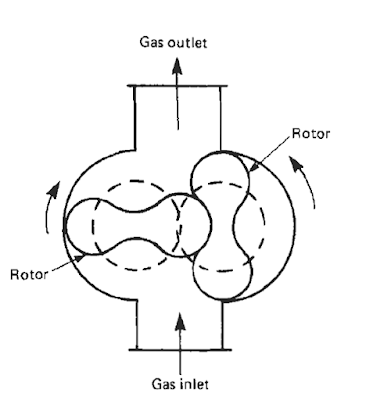Positive
displacement flowmeters have a cyclic mechanism designed to pass a fixed volume
of fluid through with every cycle.
Every cycle
of the meter’s mechanism displaces a precisely defined (positive) quantity of
fluid, so that a count of the number of mechanism cycles yields a precise
quantity for the total fluid volume passed through the flowmeter.
Example of
Rotary Displacement flowmeter is shown below:
Each shaft
revolution in a Rotary Displacement flowmeter represents a certain volume of
fluid that has passed through the meter.
Besides,
Rotary Displacement flowmeters, we have other types like Diaphragm meter
(Bellows type), Liquid sealed drum (wet gas meter), Pistons etc.
Advantages of using Positive Displacement
Flowmeters
Positive
displacement flowmeters are immune to swirl and other large-scale fluid
turbulence, and can be installed anywhere in a piping system. There is no need
for long sections of straight of straight-length pipe upstream or downstream as
with the case of Ultrasonic Flowmeters. Positive displacement flowmeters are also very
linear, since the mechanism cycles are directly proportional to fluid volume.
Limitations of Positive Displacement
Flowmeters
The sealing
surfaces of rotating mechanisms are subject to wear and accumulating
inaccuracies over time. The finely machined construction of a positive
displacement flowmeter can suffer damage from abrasive materials like grit
present in the fluid, meaning that these types of flowmeters are only used for
clean fluid flow streams.
You
can also read:
Applications of Positive Displacement
Flowmeters
Positive
displacement meters are commonly used for custody transfer of gas. Positive Displacement meters can measure high viscosity clean liquids as high as 1 Million centipoise, they also
find application in water flow measurement.
Don't miss out on key updates, join our newsletter list here.

No comments:
Post a Comment